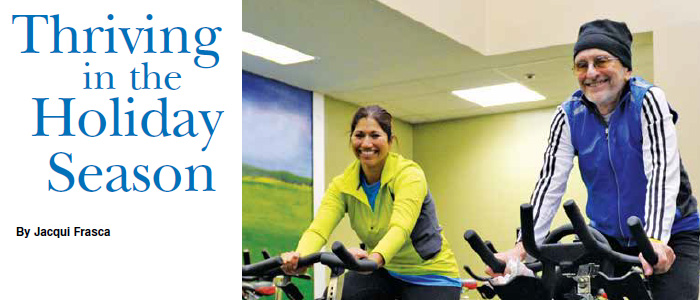
While holidays are beyond wonderful for bringing people and families together, there are a few signature parts of the holidays that can also throw people wildly off-track when trying to maintain their health and fitness goals. Among these, traditional season indulgences, holiday parties and a lack of physical activity are some of the biggest offenders. Seasonal drinks, sides and desserts add up quickly and seem to be everywhere you turn.
In a time where seasonal affective disorder (SAD), colder temperatures, sicknesses and untypical eating habits are more prominent, it is extremely important to keep up a regular exercise routine that works for you and honors a balanced diet. According to exercise specialist Mary Ann Guarnieri at WellStar Health Place, “Exercise has proven to boost an individual’s immune system, which can help combat these sicknesses. In addition to an improved immune system, exercise releases ‘feel good’ chemicals in the brain to help combat depression.” Research shows that 30 minutes of exercise at least five days a week can vastly improve our health, as well as help prevent obesity, heart disease and chronic health conditions like hypertension and diabetes.
Back in the Swing of Things
There’s a routine many experience around the colder holiday months—overeating, under-exercising and scrambling to get rid of the excess weight before summer by making a New Year’s resolution about it. In fact, the average American gains anywhere between five and seven pounds during the holidays, so it’s important to maintain a fitness regimen and balanced diet. Exercising during the colder months has been shown to improve mood, increase energy levels and help with a more restful night’s sleep—things that are immensely beneficial if in-laws coming to town tends to wear on you.
“Shorter, grayer days can definitely affect our desire to be active, but achieving and maintaining a healthy weight can only be done via a healthy lifestyle,” says Beth Linn, MBA, ACE, certified personal trainer and health coach at Real Fitness, LLC, in Acworth. “Lifestyle means year-round—if you have been consistent with exercise during the warmer months, you do not want to lose those gains by being sedentary until spring and having to start all over again. I’ve never heard anyone say on April 1, ‘I wish I had exercised less throughout the winter!’”
Sometimes, starting can be the most challenging part of keeping up or starting a new routine. “During the holidays, it can be hard to find the time and even the motivation to get out and exercise in regards to having so many other things that need to be accomplished,” says Farrah Spellman, assistant director of the Employee Wellness Center of Health Promotion and Wellness, part of the WellStar College of Health & Human Services at Kennesaw State University. “To increase motivation and fit exercise into your busy holiday schedule, recruit family members to get out and exercise with you. You can increase physical activity with quality family time.”
You want to be your ally in fitness success, and the best way to do that is to set realistic, achievable goals by committing to planned exercises that you enjoy. Ask a friend to walk or run with you, or commit to fitness classes you’re excited to go to. “Sign up for community races such as the Gobble Jog on Thanksgiving morning or the Wonderful Days of Winter run in January,” Guarnieri suggests. “Walking an extra lap around the mall while shopping and parking far away from the mall entrance is a wonderful way of using every opportunity to exercise.” Linn advises people to start a new tradition and have a supportive network of family and friends in place to help you achieve your goals without throwing a wet blanket over the festivities. “I have friends who have met every Christmas Day for the past 30 years for a group run,” she says. “It always ends with some holiday cheer, but the exercise was accomplished first, and the activity creates an annual memory that bonds their lives together. They would never think of skipping it.”
“Cold weather is not a reason to abandon your workout regimen, but it is a good time to make some adjustments,” says Dr. Georgia Reggie Mason, Total Health Lead for Kaiser Permanente. “Rather than run or walk outdoors, take advantage of indoor tracks. If you don’t have a gym membership, many malls even open early to allow the public to walk. From push-ups and crunches to squats and jumping jacks, there are tons of exercises that can be done indoors.” Incorporate the festivities by rousing your family after holiday dinners to walk around the neighborhood and enjoy the decorations you see, or head to your nearest skating rink and hit the ice. You can even coax your book club to walk while you review the latest read.
What’s most important, however, is if you are getting back into a fitness routine after not exercising for awhile, take it slow. Rather than trying to run three miles when you haven’t run in months, set aside time and run for the first 10–20 seconds of every minute. This will kick-start your body into an anaerobic state and small, intense bursts of activity may help increase your endurance. While getting back in shape after a lapse, Linn and Spellman also suggest consulting your physician and starting with a couple sessions of brisk cardio a week, maintaining that schedule and then adding in some resistance training.
Tips for Holiday Cooking—and Eating
Let’s not forget, this is an important time of year when holidays and festivities serve to bring people together often in the spirit of giving, but holiday favorites don’t need to be avoided altogether. In addition to exercise, portioning and planning are important in the food department as well, especially if that cookie tray or pie station leaves you a little weak at the knees. The strategies for successfully avoiding overindulging are endless, and there are even a few tips and tricks you can utilize in the kitchen to make the holiday table all that much healthier.
First, eat a well-balanced meal before an event, be it an office party, potluck or community gathering. Eating small meals throughout the day is the best way to keep your blood sugar levels up and avoid indulging in an oversized meal three times a day, especially if one of them comes with starchy sides and buttery desserts. “The holiday season can get away from us,” says Marc Taft, executive chef and owner of Chicken and the Egg in Marietta. “We get on the scale in January and try and figure out where the 10 extra pounds came from.” Foods native to the holidays tend to be richer, more fattening and more indulgent than what makes up our usual eating routines, so Taft recommends standing far from the food table while at parties, seeking out the healthiest option and indulging in that first, be the person who brings a healthy dish to ensure a healthy choice, keep healthy snacks at hand to help avoid (most) of the temptations your co-workers will no doubt be bringing to the office, avoid shopping when hungry and eat a mint, as we tend to eat less when our mouths feel clean.
Keep in mind that the foods that are best for your body also tend to be dishes where you can identify all or most of the ingredients by sight, and you can’t go wrong with seasonal vegetable-heavy sides cooked lightly in oil rather than animal fats. “It is not only important to vary your diet with fresh seasonal foods, it really should be the only way we eat,” Taft says. “Those who do not stop to consider the reasons are the ones that force restaurants to have items on the menu year-round.” Eating local and seasonal means less energy used to transport, store and preserve fresh food; saves you money and keeps your money in your community; and is unarguably better for you, as food is healthiest at its peak ripeness and will have more vitamins, minerals and antioxidants to help you feel your best.
Jeffrey Gardner, executive chef at Common Quarter in east Cobb, opts for local, seasonal produce as often as possible. “Eating fresh seasonal foods is very important because you’re getting each ingredient at its peak for both flavor and nutrients. Have you ever tried to eat blueberries in January? They’re nothing like the sweet, delicious blueberries we get in July,” he says. “In the colder months, the variety of beets, greens and squash that are available to us are fantastic options to keep us on the health train. Most important to maintaining a healthy lifestyle, in my opinion, is variety. Eating seasonally keeps variety an option throughout the entire year.”
While many at holiday events will expect classics dishes, try switching up dishes or ingredients for healthier options this year. Tiffany Gray, certified nutritionist and executive chef and owner of A Little Bit of Heaven, also in east Cobb, opts for coconut and almond milks as substitutes for heavy cream or milk to enhance flavors without added dairy, while Gardner suggests preparing holiday favorites in styles that are lighter by nature, like Japanese, Argentinian or Vietnamese. “I love the Southern Italian Christmas Eve tradition of the Feast of the Seven Fishes,” he says. “Fish, especially within an Italian framework, instantly lends itself to lighter preparations; and it’s a nice way to introduce something new around the holidays.”
















